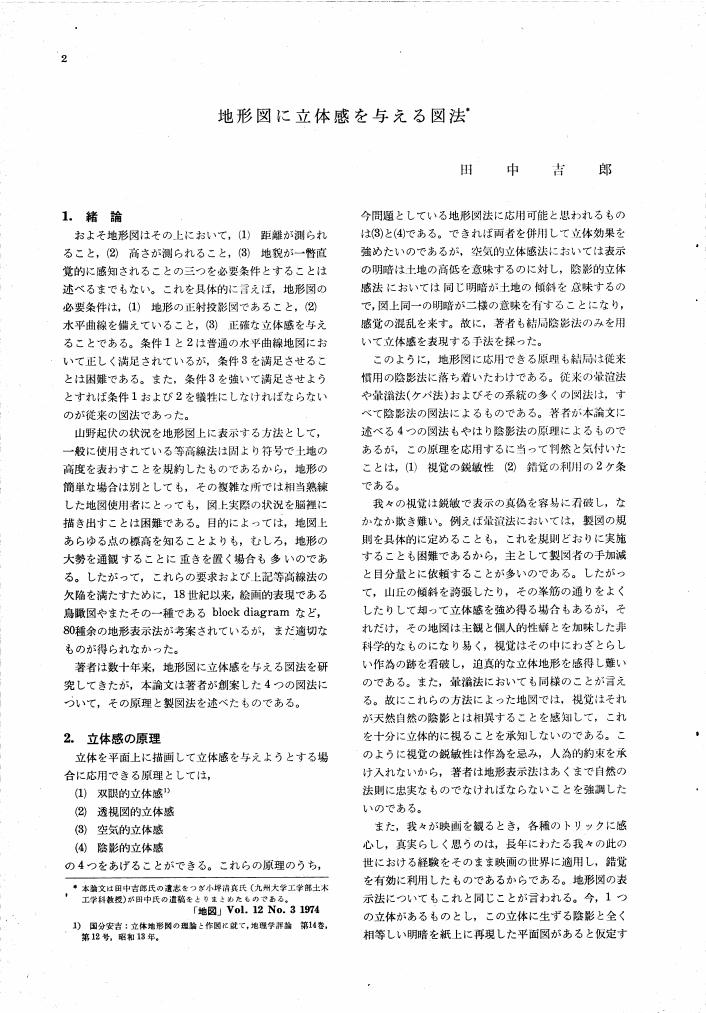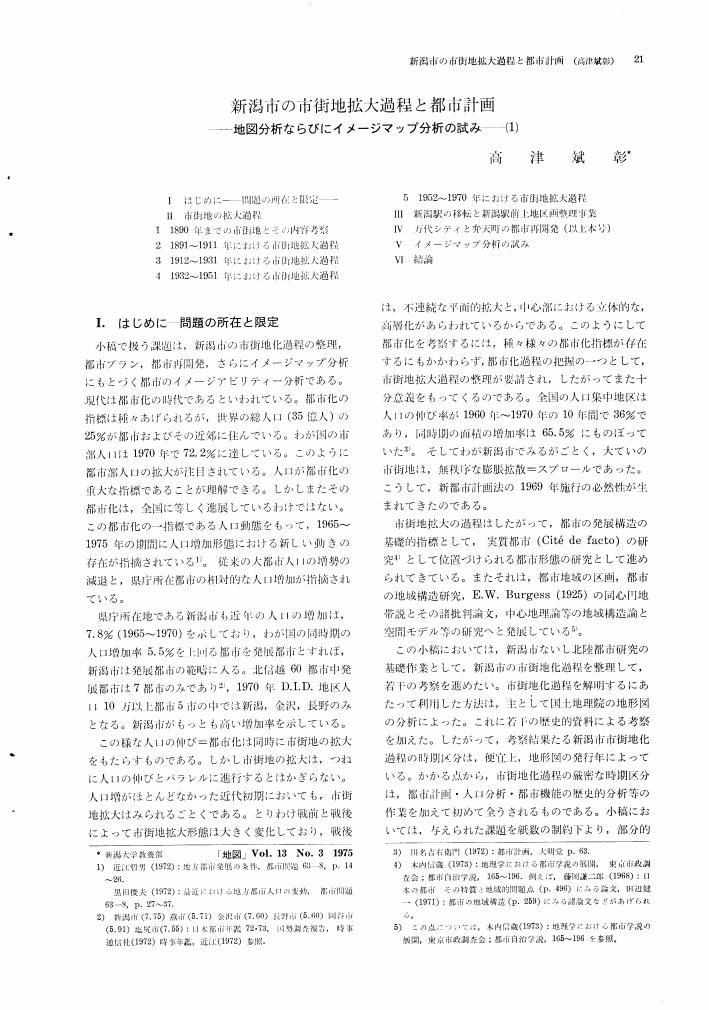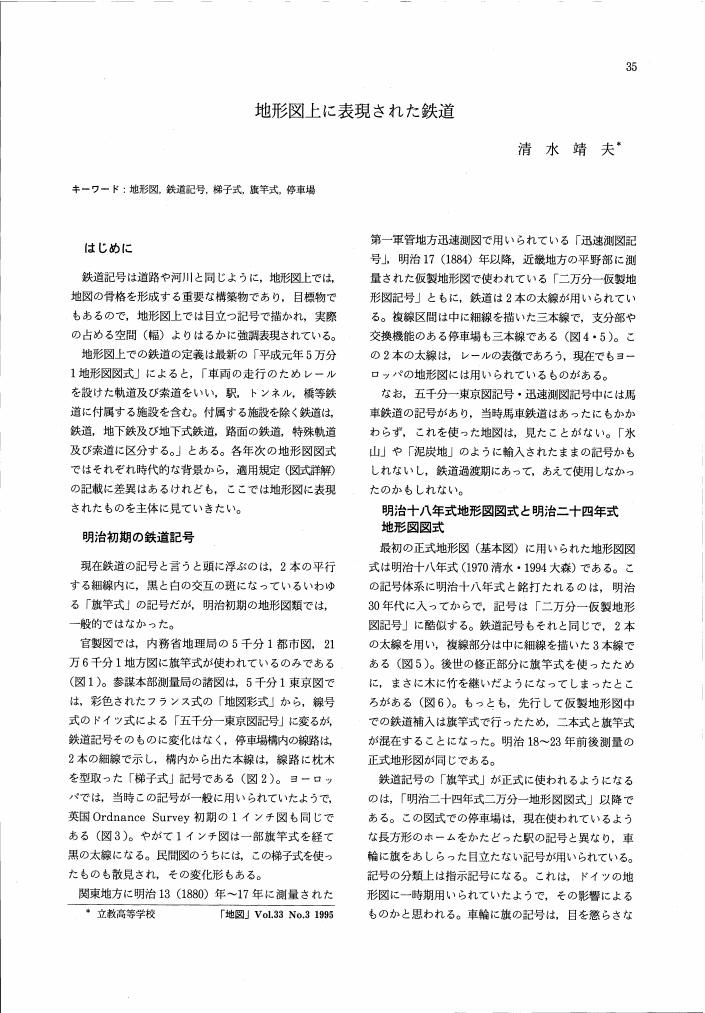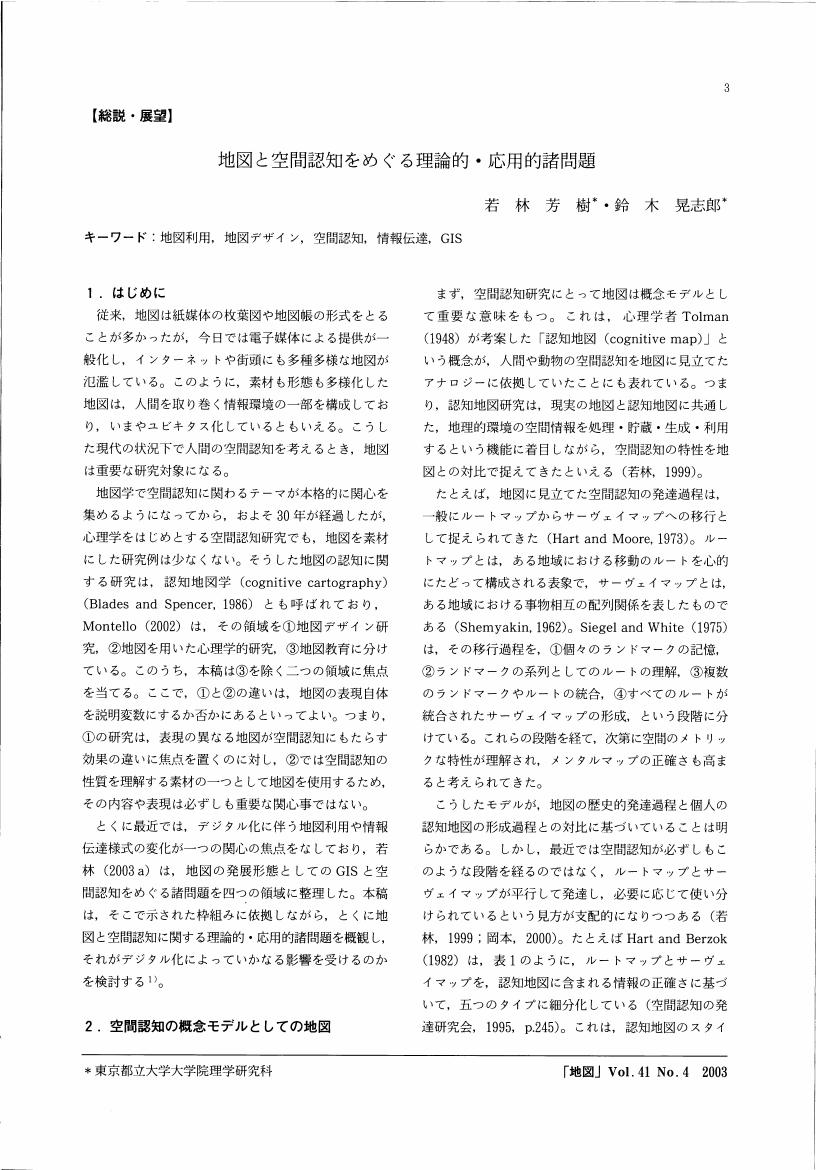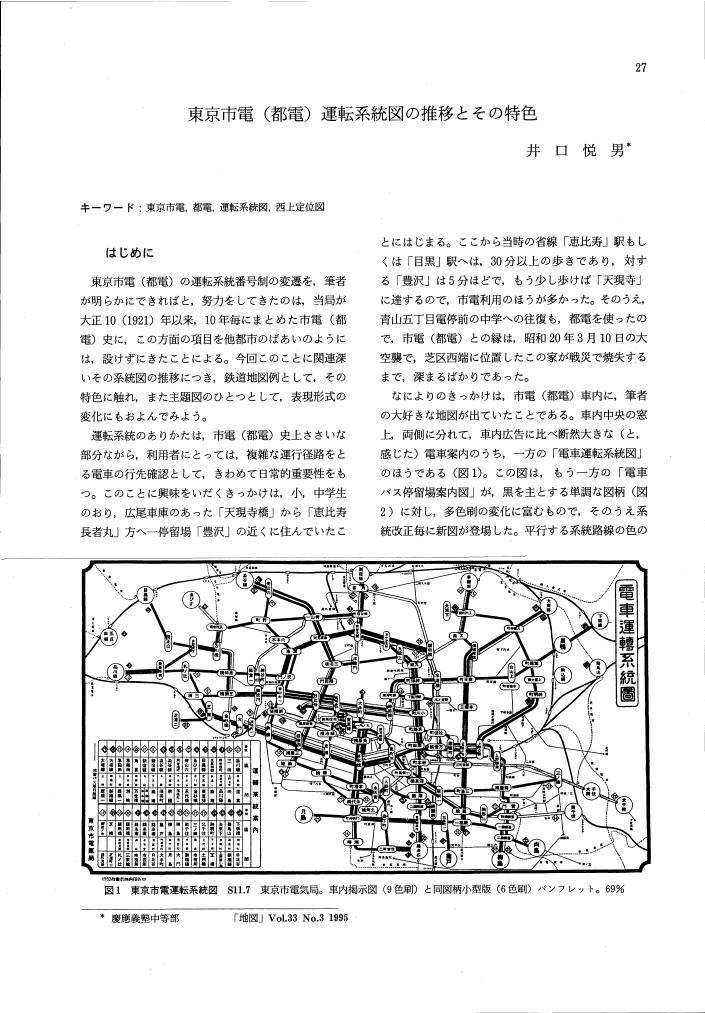- 著者
- 千歳 壽一
- 出版者
- 日本地図学会
- 雑誌
- 地図 (ISSN:00094897)
- 巻号頁・発行日
- vol.46, no.3, pp.29-39, 2008-09-30 (Released:2011-07-19)
- 参考文献数
- 4
9 0 0 0 OA 中国地図作成の歴史(通史) ―常にトップを走り続けて来た中国の測量・地図作成史―
- 著者
- 今村 遼平
- 出版者
- 日本地図学会
- 雑誌
- 地図 (ISSN:00094897)
- 巻号頁・発行日
- vol.53, no.3, pp.17-24, 2015-06-30 (Released:2016-11-17)
- 参考文献数
- 3
9 0 0 0 OA 日本地図学会の足跡 ~創始と活動停止から新たなスタートへ~
- 著者
- 菊地 正浩
- 出版者
- 日本地図学会
- 雑誌
- 地図 (ISSN:00094897)
- 巻号頁・発行日
- vol.51, no.1, pp.29-32, 2013 (Released:2016-11-17)
9 0 0 0 OA 羽田空港の歴史
- 著者
- 衣本 啓介
- 出版者
- 日本地図学会
- 雑誌
- 地図 (ISSN:00094897)
- 巻号頁・発行日
- vol.48, no.4, pp.4_7-4_14, 2010 (Released:2012-03-28)
- 参考文献数
- 3
9 0 0 0 OA 添付地図
- 出版者
- 日本地図学会
- 雑誌
- 地図 (ISSN:00094897)
- 巻号頁・発行日
- vol.32, no.2, pp.AP1-AP2, 1994-06-30 (Released:2011-07-19)
9 0 0 0 OA 地形図に立体感を与える図法
8 0 0 0 OA 江戸時代作製の張抜き地形模型『防長土図』
- 著者
- 三浦 肇 川村 博忠
- 出版者
- Japan Cartographers Association
- 雑誌
- 地図 (ISSN:00094897)
- 巻号頁・発行日
- vol.20, no.2, pp.20-26, 1982-06-30 (Released:2011-07-19)
- 参考文献数
- 5
8 0 0 0 OA 近代日本における疾病地図の成立と展開
- 著者
- 荒堀 智彦 若林 芳樹
- 出版者
- 日本地図学会
- 雑誌
- 地図 (ISSN:00094897)
- 巻号頁・発行日
- vol.60, no.2, pp.19-26, 2022-06-30 (Released:2023-09-14)
- 参考文献数
- 26
Since the beginning of the COVID-19 pandemic in 2019, disease maps have attracted a lot of public attention. Nevertheless, thematic maps have been rather neglected in the history of cartography as pointed by Robinson (1982). Koch (2011, 2017) has traced the history of disease maps in Western countries, but little is known about their history in Japan. This study addressed this gap by tracing the development of disease mapping in modern Japan in comparison to its history in Western countries. Documents pertaining to an outbreak of cholera in Meiji era indicated that the first disease map of Japan was published in 1879, after the development of Japanese health statistics.However, since the topographic map of the country was incomplete at that time, the base map was not accurate. In 1885, a disease map of Japan was published using choropleth map based on a surveymap. Concerning large-scale map within the city, a dot map of cholera cases of central Tokyo was developed in 1896. The Taisho era saw an uprise in the publication of a wide range of disease maps that presented distributions of infectious agents or prevention measures for epidemics. Thus, disease maps in modern Japan were developed a little later than those in Western countries, paralleling the development of health statistics and survey maps.
8 0 0 0 OA 日本の国郡区域と新しい広域行政区画の展望
- 著者
- 齊藤 忠光
- 出版者
- 日本地図学会
- 雑誌
- 地図 (ISSN:00094897)
- 巻号頁・発行日
- vol.52, no.2, pp.2_1-2_16, 2014-06-30 (Released:2016-11-17)
- 参考文献数
- 19
This paper looks at the process of establishing the historic administrative district areas and county areas as Japan established itself as a single nation and the transitional changes that led to today's prefectures, and the perspective for future wide-area administrative districts in Japan.Japan's historic administrative district areas and county areas comprised a regional administration system, established by the ancient Japanese state under the Ritsuryo legal code, based on the regional systems of China and Korea.The old maps from these times show the process of change from administrative districts to territorial divisions that identify regions, that occurred in the early modern period of feudal society, after the historic administrative district areas and county areas that formed the administrative districts of ancient Japan became superficial in medieval times.These maps also show that, with the further progression into the Meiji Restoration period, prefectures were established in the place of feudal domains, although these prefectural districts were established in line with the historic administrative district areas and county areas that formed the regions of early modern feudal society. The process through which counties became regional administrative districts possessing juridical personality, and then subsequently returned to geographical naming that identified regions after acquiring the role of administrative regions is also shown.In addition, these maps show the meandering process through which the prefectural districts, in other words the wide-area administrative districts that followed the establishment of prefectures in the place of feudal domains, were established, and they can also be applied to the analyses of proposals for the far-sighted yet un-realized further merging of prefectural districts.The ancient Japanese administrative district areas and county areas that underwent these transitional changes maintained regions that were coherent in terms of geography and climate and still exist today as cultural and historical regions.Meanwhile, the municipalities that comprise the basic local authorities that are closest to today's residents were expanded during the mergers of municipalities from the Meiji to the Showa period and subsequent mergers in the Heisei period, and inverse phenomena, namely the creation of cities with wider areas than prefectures, also occurred. However, many instances where the old county districts have literally become cities in their own right give testimony to the geographical coherence of the old county districts.In view of these prefectures, which comprise the new wide-area administrative districts, and the current status of the expanded municipalities, the objective of this study is to introduce proposals for wide-area provinces that will form the next new wide-area administrative districts, and to form a perspective for future wide-area administrative districts in Japan.
8 0 0 0 OA 新潟市の市街地拡大過程と都市計画 地図分析ならびにイメージマップ分析の試み
- 著者
- 高津 斌彰
- 出版者
- 日本地図学会
- 雑誌
- 地図 (ISSN:00094897)
- 巻号頁・発行日
- vol.13, no.3, pp.21-30, 1975-09-30 (Released:2011-07-19)
- 参考文献数
- 24
8 0 0 0 OA 添付地図
- 出版者
- 日本地図学会
- 雑誌
- 地図 (ISSN:00094897)
- 巻号頁・発行日
- vol.12, no.4, pp.AP1-AP2, 1974-11-30 (Released:2011-07-19)
- 著者
- 岡谷 隆基
- 出版者
- 日本地図学会
- 雑誌
- 地図 (ISSN:00094897)
- 巻号頁・発行日
- vol.60, no.2, pp.12-18, 2022-06-30 (Released:2023-09-14)
- 参考文献数
- 20
Author carried out this study for clarifying topographical characteristics and verifying scale of natural phenomenon in the places indicated by the “Shizensaigaidenshohi” (monument of natural disaster). The followings are the major results.1) Clarification of topographic characteristics where a “Shizensaigaidenshouhi” stands or indicates.Most of the place where “Shizensaigaidenshouhi” (monument of natural disaster, simply referred to as “the monument” in this article) stands or indicates, locates not only in very low areas (e.g. flood plain), but also in a little bit higher areas (e.g. natural levee). This is because the monument building was not reasoned by heavy rainfall or flood itself, but by the damage of lives or properties which exist in higher areas.2) Verification of scale of natural phenomenon which brought disaster where a “Shizensaigaidenshouhi” stands or indicates.Past flood depth inferred by the description of the subject monuments was slightly low or equal to that estimated by modern hazard map. In early and middle of the 20th century, many flood disaster happened and the relevant monuments were built thereafter, but in the late 20th century, the number of severe floods which recorded in the monuments decreased. However, frequency of heavy rainfall is increasing recently. This suggests flood disasters likely to be recorded in the monuments would occur again in the near future.These results show that location of a “Shizensaigaidenshouhi” stands or indicates prefers a little bit higher areas as people lives more in such areas compered to lower land and also show that past flood depth inferred by the description of the subject monuments was compatible with that estimated by modern hazard map.Map symbol “Shizensaigaidenshohi” is recently introduced to the basic topographic maps, and the new topographic maps therefore provide people with new map reading experience, which might raise people's awareness of disaster prevention as existence of “Shizensaigaidenshohi” is deeply relating to topography.
- 著者
- 村越 真 満下 健太 小山 真人
- 出版者
- 日本地図学会
- 雑誌
- 地図 (ISSN:00094897)
- 巻号頁・発行日
- vol.58, no.4, pp.1-16, 2020-12-31 (Released:2022-04-19)
- 参考文献数
- 51
This study examined whether students can recognize the risk of natural hazards using topographic or hazard maps, and whether recognition accuracy improves by learning about the relationships between topographic features and hazards from the viewpoint of map literacy. An experiment was conducted with 37 student participants and 3 natural hazard experts. Risk evaluation of sediment-related hazards for 6 sites and floods for 5 sites was required with 7-point scale, both with topographic maps and with hazard maps. The selected sites were either high risk with the risks displayed, high risk without the risks displayed, or low risk, and the participants were randomly assigned either to the experimental group or the control group. The experimental group participants learned about the relationships between topographic features and the risk of natural hazards for 10 minutes, and the control group participants learned about the risk of natural hazards without mention of the relationships. Risk evaluations for the 11 sites were required twice, before and after the learning sessions. As a result, participants were able to evaluate the risk of natural hazards to some extent even with topographic maps, but there were also some sites where they could recognize risks first by using hazard maps. Evaluated risks for many sites declined when the hazard risk was higher but not displayed on the hazard maps, while the experts maintained risk evaluations for such sites. Free descriptions explaining the evaluations revealed that the experimental group acquired knowledge of the relationships between topographic features and risk of natural hazards from the learning sessions, but it did not appear to affect their evaluations of risk. Based on the results, it was argued that autonomous judgments of the risk of natural hazards required knowledge of the relationships between topographic features and risky area of natural hazards as well as the reasons for the relationships and topographic features that should be paid attention to. Theoretical and practical implications for map literacy were also discussed.
7 0 0 0 OA 新潟市の市街地拡大過程と都市計画
- 著者
- 高津 斌彰
- 出版者
- Japan Cartographers Association
- 雑誌
- 地図 (ISSN:00094897)
- 巻号頁・発行日
- vol.13, no.4, pp.1-7, 1975-12-01 (Released:2011-07-19)
- 参考文献数
- 2
7 0 0 0 OA 地形図上に表現された鉄道
- 著者
- 清水 靖夫
- 出版者
- Japan Cartographers Association
- 雑誌
- 地図 (ISSN:00094897)
- 巻号頁・発行日
- vol.33, no.3, pp.35-40, 1995-09-30 (Released:2011-07-19)
- 参考文献数
- 8
6 0 0 0 OA 地図と空間認知をめぐる理論的・応用的諸問題
- 著者
- 若林 芳樹 鈴木 晃志郎
- 出版者
- Japan Cartographers Association
- 雑誌
- 地図 (ISSN:00094897)
- 巻号頁・発行日
- vol.41, no.4, pp.3-16, 2003-12-28 (Released:2011-07-19)
- 参考文献数
- 107
- 被引用文献数
- 1
6 0 0 0 OA 東京市電 (都電) 運転系統図の推移とその特色
- 著者
- 井口 悦男
- 出版者
- Japan Cartographers Association
- 雑誌
- 地図 (ISSN:00094897)
- 巻号頁・発行日
- vol.33, no.3, pp.27-34, 1995-09-30 (Released:2011-07-19)
- 参考文献数
- 2
6 0 0 0 OA 陸地測量部における伊能図の利用
- 著者
- 菱山 剛秀
- 出版者
- 日本地図学会
- 雑誌
- 地図 (ISSN:00094897)
- 巻号頁・発行日
- vol.56, no.1, pp.1_65-1_70, 2018-03-31 (Released:2019-06-17)
- 参考文献数
- 10
6 0 0 0 OA 「鉄道旅行案内書」の地図
- 著者
- 中川 浩一
- 出版者
- Japan Cartographers Association
- 雑誌
- 地図 (ISSN:00094897)
- 巻号頁・発行日
- vol.33, no.3, pp.15-26, 1995-09-30 (Released:2011-07-19)
- 参考文献数
- 4
5 0 0 0 OA 地形図にみる「谷」地名と「沢」地名
- 著者
- 谷治 正孝
- 出版者
- 日本地図学会
- 雑誌
- 地図 (ISSN:00094897)
- 巻号頁・発行日
- vol.38, no.Supplement, pp.30-31, 2000 (Released:2011-07-19)





